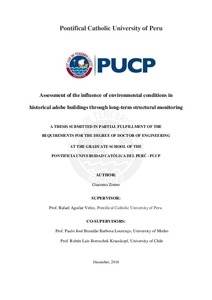Assessment of the influence of environmental conditions in historical adobe buildings through long-term structural monitoring
Abstract
Historical earthen buildings are vulnerable to external solicitations, as earthquakes, tsunamis, environmental conditions and others, and, often, they are under unacceptable risks. For all these aspects, earthen buildings need an indispensable intervention but also an accurate diagnosis to respect the modern restoration principles. Nowadays, the research field related to the structural analysis of existing earthen buildings is very far from a complete and exhaustive knowledge. For studying these types of buildings, experimental investigations are mandatory. The thesis has the ambitious goal to fill the lack of knowledge about the dynamic behavior of historical earthen buildings. The work started with the study of effects of temperature and humidity on the “earth material”. For this reason, single adobe walls were built and analyzed by a continuous monitoring of the internal and external environmental parameters and dynamic properties to understand their behavior as simple adobe construction systems. The main challenges in this stage were the development of a suitable algorithm to automatically identify the dynamic parameters, the study of the internal distribution of temperature and humidity, and, the analysis of the environmental effects on the long-term monitoring of simple adobe systems. The results showed a good heat storing capacity of the walls and the existence of an internal thermal flow connected to a combined effect of air temperature, wind, solar radiation, and wall orientation. Furthermore, environmental seasonal and daily effects were first identified and subsequently isolated from the structural response, demonstrating a clear inverse relationship between temperature and dynamic properties. After this first stage, the application of the achieved knowledge was applied to a real case study to verify the obtained results in a larger scale. The Church of San Pedro de Andahuaylillas was chosen as case study. This church was built in the sixteenth century and represents a suitable example of historical earthen building. This architecture is one of the most amazing and beautiful example of religious art, solemn testimony of the Andean culture. To this church, a long-term monitoring system was applied for a better understanding of the earthen building behavior. The results indicated that he environmental variable affect the structural behavior at two levels: a seasonal long-term influence was detected as well as a daily short- term one. Seasonal effects caused variations of up to 8% in natural frequencies, and shorter-term influences were also verified causing variations of up 3.8%. Daily results showed a delayed effect of the environmental conditions in the structural response. Finally, multiple linear regression models were developed using the absolute humidity as independent variable to successfully predict the long-term frequency variation of the analyzed case study for structural health assessment purpose. Los edificios históricos de tierra son vulnerables a solicitudes externas, como terremotos, tsunamis, condiciones ambientales y otros, por lo que están bajo riesgos inaceptables. Para todos estos aspectos, los edificios de tierra necesitan una intervención indispensable pero también un diagnóstico preciso para respetar los principios modernos de restauración. Hoy en día, el campo de investigación relacionado con el análisis estructural de los edificios de tierra existentes está muy lejos de un conocimiento completo y exhaustivo. Para el estudio de este tipo de edificios, las investigaciones experimentales son obligatorias. La tesis tiene el objetivo ambicioso de cubrir la falta de conocimiento sobre el comportamiento dinámico de los edificios históricos de tierra. El trabajo comenzó con el estudio de los efectos de la temperatura y la humedad en la tierra como material. Con este fin, se construyeron muros de adobe y se analizaron mediante un monitoreo continuo de los parámetros ambientales internos y externos y de las propiedades dinámicas con el objetivo de comprender su comportamiento como sistemas de construcción. Los principales desafíos en esta etapa fueron el desarrollo de un algoritmo adecuado para identificar automáticamente los parámetros dinámicos, el estudio de la distribución interna de la temperatura y la humedad, y el análisis de los efectos ambientales en el monitoreo a largo plazo. Los resultados mostraron una buena capacidad de almacenamiento de calor de los muros y la existencia de un flujo térmico interno conectado a un efecto combinado de la temperatura del aire, el viento, la radiación solar y la orientación. Además, los efectos ambientales estacionales y diarios fueron identificados primero y luego fueron aislados de la respuesta estructural, demostrando una clara relación inversa entre la temperatura y las propiedades dinámicas. El conocimiento obtenido en esta primera etapa se aplicó a un estudio de caso real para verificar los resultados obtenidos en una escala mayor. El caso de estudio elegido fue la iglesia San Pedro de Andahuaylillas. Este templo fue construido en el siglo XVI y es la muestra más emblemática de arte religioso, solemne testimonio de la cultura andina. Para esta iglesia, se aplicó un sistema de monitoreo a largo plazo para una mejor comprensión del comportamiento de los edificios de tierra. Los resultados indicaron que la variable ambiental afecta el comportamiento estructural de dos maneras: se detectó una influencia estacional a largo plazo y una diaria a corto plazo. Los efectos estacionales causaron variaciones de hasta 8% en las frecuencias naturales, y también se verificaron influencias a corto plazo, lo que causó variaciones de hasta 3.8%. Los resultados diarios mostraron un efecto retardado de las condiciones ambientales en la respuesta estructural. Finalmente, se desarrollaron modelos de regresión lineal múltiple utilizando la humedad absoluta como variable independiente para predecir con éxito la variación de frecuencia a largo plazo con el fin de evaluar la salud estructural.
Temas
Construcciones de tierra--Aspectos ambientales
Construcciones de adobe--Aspectos ambientales
Edificios históricos--Conservación y restauración
Construcciones de tierra--Análisis estructural
Construcciones de adaobe--Análisis estructural
Construcciones de adobe--Aspectos ambientales
Edificios históricos--Conservación y restauración
Construcciones de tierra--Análisis estructural
Construcciones de adaobe--Análisis estructural
Para optar el título de
Doctor en Ingeniería





